Traveling With Toys
When I travel, both my wife and I tend to bring lots of electronic toys. We use a quad band GSM cellphone to keep in touch as it seems to work everywhere, but sometimes with significant roaming charges. We carry computers to write travel logs. We take PDA's for handheld entertainment during what would be short periods of downtime and on airplanes. We take iPods and noise cancelling headphones (HIGHLY useful on airplanes). And of course, we take batteries, charges and power adaptors to keep all this stuff going.
I've already written about some of the power related issues at my Camping Power and USB Tips pages so I'll repeat only a little of that information here. This page is not so much about how to keep the stuff running, but instead, what stuff to bring.
We like to travel as light as possible. Of course, we could travel lighter by jettisoning all of this electronic fluff, but we are nerds and not bringing these toys is unacceptable. So in order to reduce the load as much as possible it would seem reasonable to share the toys and bring only one of each thing. In practice, this doesn't work so well. This stuff can tend to break or get lost or stolen. While we haven't had much problem with losing the stuff, we have experienced things failing at times. Failure of one critical piece, such as a universal battery charger, can bring the whole kit down. We've concluded that redundancy is good. Both Sandy and I bring a complete kit EACH but we coordinate the bits and pieces so that most or all of the bits and pieces can be mixed or matched to work around individual losses.
Therefore, we tend to carry TWO computers, TWO PDAs, TWO iPods, TWO sets of headphones, TWO cameras and TWO methods of charging all this stuff. Each carries this kit in individual backpacks that are held as carry on luggage so that it stays with us. We also carry our meds, travel paper work and other necessary documents in these backpacks so that we will be less likely to be separated from the hard to replace stuff. Clothes and other bulk material goes into checked luggage.
The Toys
What drives all of the need for support is the toys themselves.
Cell phones. We only carry one cellphone, primarily because we only have one that will work most every we go. However, telephones are so common around the world that if the cellphone dies, we can just switch to regular phones and we just don't use it that much. We hate the monthly charge for this phone and it's only $20/mo. It's just too expensive to carry multiple plans to allow the use of multiple international GSM phones. At home, I have my own phone, but it is a prepaid TracFone that won't work outside the US. It costs $6/mo. The cellphone charges from a Juice70 (see below) with a Motorola phone tip.
Computers. We bring two laptop computers, at the current time both are older Apple iBooks. We both have newer computers but older computers are often adequate for travel and they carry less value so that if damaged or lost, they represent a smaller loss. iBooks are also tough as nails and tend to survive the rigors of travel well. We charge the computers from one Apple iBook adaptor and an iGo Juice 70 with an iBook tip.
PDA's. We also bring two PDAs, they aren't completely necessary, but they are handy because they can go in a pocket and provide some entertainment in the inevitable queues. I also use mine as as alarm clock and calendar. My Sony Clie PDA will charge from the Juice 70 with a Clie tip or a USB cable that can plug into a computer, the Juice 70 or any other USB source.
iPods. Music is a necessary diversion. I also use the balance of the disk space on a 60 GB iPod to back up video and other massive data. Noise cancelling headphones (good ones) are really helpful on airplanes. They really do cut out much of the noise. The iPods will both charge via USB. The iPod photo will also charge from FireWire (from a computer) or the iPod speakers (when they are plugged in).
Cameras. I have a camcorder that does stills, Sandy has a still camera that does video. We both take pictures and video and them we merge the results into photo albums and movies. Sandy's camera uses rechargeable AA batteries, mine uses Sony Li-ion batteries. My camcorder can charge from the Juice70 or the batteries can be separately charged from a dedicated 110 to 240 volt travel charger.
Chargers
All of this stuff needs to be recharged. All of these devices come with chargers, but they are all different and there are so many of them. Instead, we've collected a minimum amount of equipment and cables to allow each device to be recharged and connected for data communications if necessary. All this charger stuff also needs to be connected to some kind of power source as well. This is where we start.
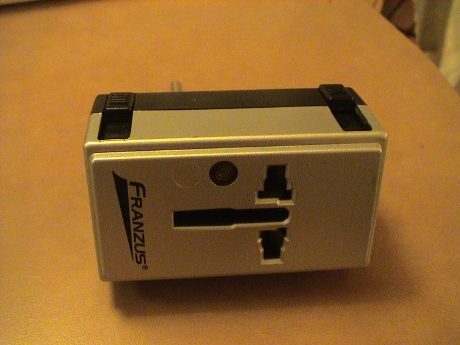 The world has split itself primarily into two AC power forms, 120 VAC and 240 VAC. Fortunately, most electronics manufacturers have found that economies of scale allow them to make electronic power adaptors that will accommodate the whole range of world power, even though the actual form of the AC power connector is different. That means that a power adaptor that is rated to 120 to 240 volts can be connected to any power socket with a simple "gender bender" that allows it to be plugged in anywhere. The user end of this device will accept the flat blades of a US style plug or the slanted blades of an Australian style plug or the fat rectangular pins of a UK plug or the round pins of a European style plug.
The world has split itself primarily into two AC power forms, 120 VAC and 240 VAC. Fortunately, most electronics manufacturers have found that economies of scale allow them to make electronic power adaptors that will accommodate the whole range of world power, even though the actual form of the AC power connector is different. That means that a power adaptor that is rated to 120 to 240 volts can be connected to any power socket with a simple "gender bender" that allows it to be plugged in anywhere. The user end of this device will accept the flat blades of a US style plug or the slanted blades of an Australian style plug or the fat rectangular pins of a UK plug or the round pins of a European style plug.
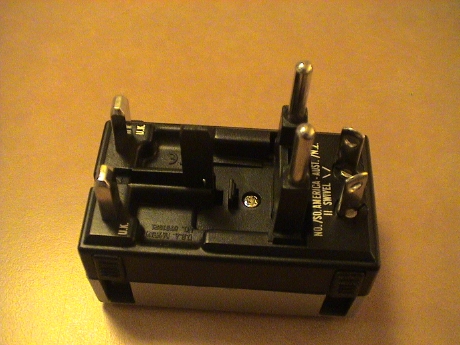 The back side has all of the plug types. These are all extended at once for this photo but normally only one would be used at any one time. Beware of most inexpensive "power converters" that may look pretty much the same. They are intended to "convert" 240 volts to 120 volts. They do this with a simple diode to half wave rectify the 240 volt source into something that approximates 120 volts. This works ok for hot plates and coffee pots, but it doesn't work for most electronics. When you buy something in ANY country, just look at the input rating. If it says something like 110 to 240 volts, 50 to 60 Hz, then it will work anywhere without fear of smoke just as long as you have one of these gender benders to allow it to be physically connected. Note that NONE of these contacts sets picks up the ground contact for ANY of the plug configurations.
The back side has all of the plug types. These are all extended at once for this photo but normally only one would be used at any one time. Beware of most inexpensive "power converters" that may look pretty much the same. They are intended to "convert" 240 volts to 120 volts. They do this with a simple diode to half wave rectify the 240 volt source into something that approximates 120 volts. This works ok for hot plates and coffee pots, but it doesn't work for most electronics. When you buy something in ANY country, just look at the input rating. If it says something like 110 to 240 volts, 50 to 60 Hz, then it will work anywhere without fear of smoke just as long as you have one of these gender benders to allow it to be physically connected. Note that NONE of these contacts sets picks up the ground contact for ANY of the plug configurations.
 Many hotel rooms and cruise ship cabins have just one outlet in a convenient spot. If you have lots of toys, you'll probably want to plug in more than one at a time. I use a 6 foot, 3 wire US style extension cord. It will allow the distribution of 120 or 240 volts (with a gender bender) to all of the devices that can accept 120 to 240 volts. Note that when powered from a 240 VAC source with the gender bender, the 120 VAC rated cord will have 240 VAC in it. This cord has heavy duty insulation and will handle it. Not all extension cords may be able to deal with twice their rated voltage. Be careful and pick a good one. Also, don't use power strips that have a surge protector in them. These can be overloaded.
Many hotel rooms and cruise ship cabins have just one outlet in a convenient spot. If you have lots of toys, you'll probably want to plug in more than one at a time. I use a 6 foot, 3 wire US style extension cord. It will allow the distribution of 120 or 240 volts (with a gender bender) to all of the devices that can accept 120 to 240 volts. Note that when powered from a 240 VAC source with the gender bender, the 120 VAC rated cord will have 240 VAC in it. This cord has heavy duty insulation and will handle it. Not all extension cords may be able to deal with twice their rated voltage. Be careful and pick a good one. Also, don't use power strips that have a surge protector in them. These can be overloaded.
Attached to the extension cord is a US style 3 outlet extender. Even though this whole mess uses the US style ground pin, most of the things that we plug in are only 2 wire anyway. It's good to have an extender that supports the ground pin just so that everything will plug in even if the ground pin isn't actually used.
This mess has the iPod speaker adaptor, an AA charger, a Juice 70, and an iBook power adaptor plugged in and there is one outlet to spare.
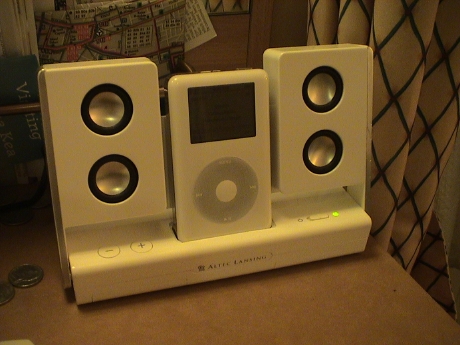 These iPod speakers run from either AA batteries or AC power. When running on AC power, the speakers also charge the iPod. The iPod can also be charged with a USB cord from a computer or some other USB sources. This is an older model iPod that will also charge via FireWire. We also carry an iPod shuffle that charges from USB.
These iPod speakers run from either AA batteries or AC power. When running on AC power, the speakers also charge the iPod. The iPod can also be charged with a USB cord from a computer or some other USB sources. This is an older model iPod that will also charge via FireWire. We also carry an iPod shuffle that charges from USB.
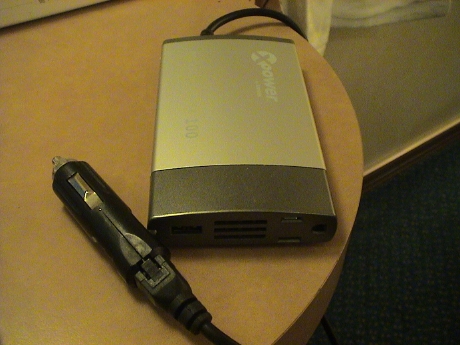 When traveling in a rental car, we use this inverter to run the stuff from a cigarette lighter socket. It provides 110 VAC or 5 volts on a USB socket. It will also work on airline power sockets, but we normally don't see those because they are usually found in business or first class.
When traveling in a rental car, we use this inverter to run the stuff from a cigarette lighter socket. It provides 110 VAC or 5 volts on a USB socket. It will also work on airline power sockets, but we normally don't see those because they are usually found in business or first class.
Beware of rental cars in some countries. Cars in Tahiti, for example, are typically positive ground, backwards from the rest of the world. That cost me a camcorder charger once. Although it just blew an internal fuse and was easily fixed when we got home, it was down for the rest of that trip.
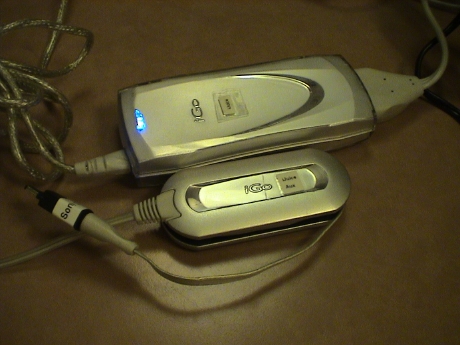 This is an iGo Juice 70. It is sort of a universal power adaptor. It will run from 110 to 240 volts, or 12 volts from a car or airline power socket. This allows it to be redundant to the inverter in that it can provide somewhat the same function. However, with the inverter one still needs an AC adaptor. The Juice 70 has a variety of "power tips" or adaptors at the device end to adapt to a variety of laptop computers. The rounded box connects to the Juice70 to allow it to charge cell phones, PDAs, iPods, cameras or many other devices simply by changing the tips (sold at extra cost, usually about $10 each) so that it can change a computer and one other item at the same time. We also have a tip that provides USB power. Note one odd behavior of the Juice70. Unless a laptop tip is connected to the main output, the secondary output used to charge other smaller stuff won't work. A laptop doesn't have to be connected, just a laptop tip.
This is an iGo Juice 70. It is sort of a universal power adaptor. It will run from 110 to 240 volts, or 12 volts from a car or airline power socket. This allows it to be redundant to the inverter in that it can provide somewhat the same function. However, with the inverter one still needs an AC adaptor. The Juice 70 has a variety of "power tips" or adaptors at the device end to adapt to a variety of laptop computers. The rounded box connects to the Juice70 to allow it to charge cell phones, PDAs, iPods, cameras or many other devices simply by changing the tips (sold at extra cost, usually about $10 each) so that it can change a computer and one other item at the same time. We also have a tip that provides USB power. Note one odd behavior of the Juice70. Unless a laptop tip is connected to the main output, the secondary output used to charge other smaller stuff won't work. A laptop doesn't have to be connected, just a laptop tip.
In the years since this page was originally written, we have upgraded our travel computers one Mac's that use the MagSafe adaptor. Since MagSafe is covered by a patent that Apple refuses to license, the Juice70 has become obsolete as it cannot charge the computers. We do use a junior form of the iGo charger to charge iDevices, now and iPad and iPod touch.
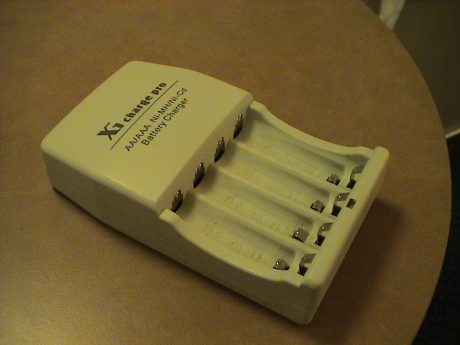 When we buy stuff, we try to get things that run on AA rechargeable batteries so that we only need one battery charger. This isn't always possible, but Sandy's cameras, the iPod speakers and my beard trimmer all run from AA batteries. We carry two chargers. This one has a US style plug that folds into the back to make it easy to carry without pointy things sticking out. This charger also comes with a 12 volt adaptor cord, but we don't bring it because we can use the inverter to run it from 12 volts.
When we buy stuff, we try to get things that run on AA rechargeable batteries so that we only need one battery charger. This isn't always possible, but Sandy's cameras, the iPod speakers and my beard trimmer all run from AA batteries. We carry two chargers. This one has a US style plug that folds into the back to make it easy to carry without pointy things sticking out. This charger also comes with a 12 volt adaptor cord, but we don't bring it because we can use the inverter to run it from 12 volts.
Communications
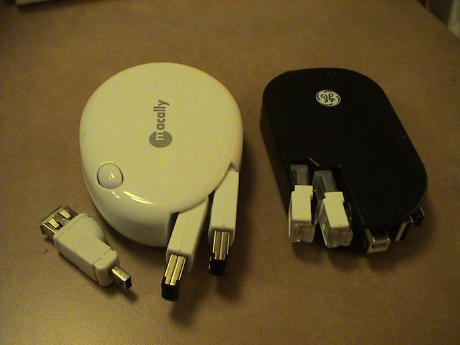 To connect things together to transfer data between devices, we mostly use these retractable cable sets so that messes of cables (that tend to get all tangled up) aren't needed. The white one is FireWire. The 6 pin to 6 pin connection can be used to connect the two computers for very high speed FireWire data transfers. An adaptor can also be connected to one end to make it a 4 pin adaptor that is used to download video from the Sony Camcorder. Both cameras use USB for still photo transfers. For this, we use the black adaptor. It has two retractable cable sets. One is USB and has a regular type A end and the very small type that is often found on digital cameras (like ours). It also has an adaptor that will turn the small end into a type B USB connection as is found on some devices like USB hubs. There is also a combination phone and ethernet cable in the black adaptor. This cable can be used to connect the modem port of a computer to the telephone network by sliding back the white plastic pieces, By sliding the white plastic pieces forward, it can be used to connect two computers together via ethernet as well or to connect a computer to an ethernet jack in a hotel or internet cafe. Sandy doesn't have any FireWire stuff so she doesn't carry a FireWire cable. However, I also carry a regular Apple 6 to 4 pin FireWire cable to allow redundant connection to the camera.
To connect things together to transfer data between devices, we mostly use these retractable cable sets so that messes of cables (that tend to get all tangled up) aren't needed. The white one is FireWire. The 6 pin to 6 pin connection can be used to connect the two computers for very high speed FireWire data transfers. An adaptor can also be connected to one end to make it a 4 pin adaptor that is used to download video from the Sony Camcorder. Both cameras use USB for still photo transfers. For this, we use the black adaptor. It has two retractable cable sets. One is USB and has a regular type A end and the very small type that is often found on digital cameras (like ours). It also has an adaptor that will turn the small end into a type B USB connection as is found on some devices like USB hubs. There is also a combination phone and ethernet cable in the black adaptor. This cable can be used to connect the modem port of a computer to the telephone network by sliding back the white plastic pieces, By sliding the white plastic pieces forward, it can be used to connect two computers together via ethernet as well or to connect a computer to an ethernet jack in a hotel or internet cafe. Sandy doesn't have any FireWire stuff so she doesn't carry a FireWire cable. However, I also carry a regular Apple 6 to 4 pin FireWire cable to allow redundant connection to the camera.
I also carry a Memory Stick USB reader so that I can read the contents of my camera and PDA memory cards. Sandy carries a "7-in-1" USB memory card reader. It uses a cable to connect to the computer but it is the same cable that we use to connect to the cameras directly if needed.
Redundancy
Virtually all of our power and data connectivity is redundant. We have two power sources to charge the computers. We have two ways to recharge AA batteries. The Clie will recharge from it's own cable or from the Juice70. The memory cards in the cameras can be read via a cable or via a memory card reader. The iPod will recharge from the speakers or two different cables. The iPod shuffle will recharge from every USB source that we have. We have two ways to power this stuff from a 12 volt cigarette lighter or airline power socket.
For some functions, we don't have redundancy. Sandy's Dell PDA will charge only from the Juice 70, she didn't bring the AC charger because it is 110 volts only. We have no way to do data communications to the Dell PDA, but we don't need to do that. I have only one cable to do data communications to the Clie PDA, but I typically don't do that from my travel computer anyway. I can get data on and off it via it's Memory Stick if absolutely necessary.
This may seem like a lot of stuff, but each individual piece is pretty light so that all of the adaptors and cables taken together weighs in at about 5 lbs and there are two of us carrying the load. The computers and cameras themselves are much heavier than the kit necessary to keep them working.
As an example, at our hotel in Rotorua New Zealand, we found that the Franzus gender benders would not fit into most of the outlets in the room because of wood trim surrounding them. Further, one of the adaptors broke. I could have probably fixed it with a Phillips head screwdriver but I didn't have one. We were able to borrow an adaptor from the hotel desk in this case, but still, having only one way to do something can lead to problems.
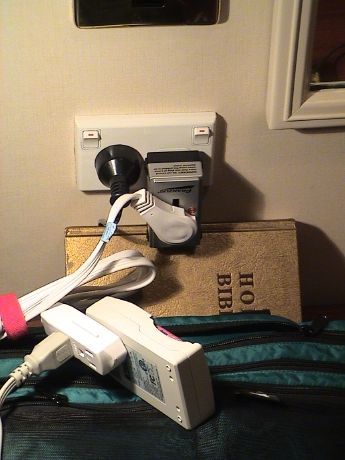 At our next hotel in Wellington, the socket was accessible but so loose that the adaptor fell right out. I used a couple of telephone books and a travel bag for ballast to prop a Gideon's Bible so that the adaptor would barely stay connected. We found a dedicated New Zealand adaptor at a supermarket nearby, but it was $18 so we passed on that one.
At our next hotel in Wellington, the socket was accessible but so loose that the adaptor fell right out. I used a couple of telephone books and a travel bag for ballast to prop a Gideon's Bible so that the adaptor would barely stay connected. We found a dedicated New Zealand adaptor at a supermarket nearby, but it was $18 so we passed on that one.
This page has been accessed  times since 24 Oct 2007
times since 24 Oct 2007
© 2007 George Schreyer
Created 24 Oct 07
Last Updated September 30, 2012
 The world has split itself primarily into two AC power forms, 120 VAC and 240 VAC. Fortunately, most electronics manufacturers have found that economies of scale allow them to make electronic power adaptors that will accommodate the whole range of world power, even though the actual form of the AC power connector is different. That means that a power adaptor that is rated to 120 to 240 volts can be connected to any power socket with a simple "gender bender" that allows it to be plugged in anywhere. The user end of this device will accept the flat blades of a US style plug or the slanted blades of an Australian style plug or the fat rectangular pins of a UK plug or the round pins of a European style plug.
The world has split itself primarily into two AC power forms, 120 VAC and 240 VAC. Fortunately, most electronics manufacturers have found that economies of scale allow them to make electronic power adaptors that will accommodate the whole range of world power, even though the actual form of the AC power connector is different. That means that a power adaptor that is rated to 120 to 240 volts can be connected to any power socket with a simple "gender bender" that allows it to be plugged in anywhere. The user end of this device will accept the flat blades of a US style plug or the slanted blades of an Australian style plug or the fat rectangular pins of a UK plug or the round pins of a European style plug. The back side has all of the plug types. These are all extended at once for this photo but normally only one would be used at any one time. Beware of most inexpensive "power converters" that may look pretty much the same. They are intended to "convert" 240 volts to 120 volts. They do this with a simple diode to half wave rectify the 240 volt source into something that approximates 120 volts. This works ok for hot plates and coffee pots, but it doesn't work for most electronics. When you buy something in ANY country, just look at the input rating. If it says something like 110 to 240 volts, 50 to 60 Hz, then it will work anywhere without fear of smoke just as long as you have one of these gender benders to allow it to be physically connected. Note that NONE of these contacts sets picks up the ground contact for ANY of the plug configurations.
The back side has all of the plug types. These are all extended at once for this photo but normally only one would be used at any one time. Beware of most inexpensive "power converters" that may look pretty much the same. They are intended to "convert" 240 volts to 120 volts. They do this with a simple diode to half wave rectify the 240 volt source into something that approximates 120 volts. This works ok for hot plates and coffee pots, but it doesn't work for most electronics. When you buy something in ANY country, just look at the input rating. If it says something like 110 to 240 volts, 50 to 60 Hz, then it will work anywhere without fear of smoke just as long as you have one of these gender benders to allow it to be physically connected. Note that NONE of these contacts sets picks up the ground contact for ANY of the plug configurations. Many hotel rooms and cruise ship cabins have just one outlet in a convenient spot. If you have lots of toys, you'll probably want to plug in more than one at a time. I use a 6 foot, 3 wire US style extension cord. It will allow the distribution of 120 or 240 volts (with a gender bender) to all of the devices that can accept 120 to 240 volts. Note that when powered from a 240 VAC source with the gender bender, the 120 VAC rated cord will have 240 VAC in it. This cord has heavy duty insulation and will handle it. Not all extension cords may be able to deal with twice their rated voltage. Be careful and pick a good one. Also, don't use power strips that have a surge protector in them. These can be overloaded.
Many hotel rooms and cruise ship cabins have just one outlet in a convenient spot. If you have lots of toys, you'll probably want to plug in more than one at a time. I use a 6 foot, 3 wire US style extension cord. It will allow the distribution of 120 or 240 volts (with a gender bender) to all of the devices that can accept 120 to 240 volts. Note that when powered from a 240 VAC source with the gender bender, the 120 VAC rated cord will have 240 VAC in it. This cord has heavy duty insulation and will handle it. Not all extension cords may be able to deal with twice their rated voltage. Be careful and pick a good one. Also, don't use power strips that have a surge protector in them. These can be overloaded. These iPod speakers run from either AA batteries or AC power. When running on AC power, the speakers also charge the iPod. The iPod can also be charged with a USB cord from a computer or some other USB sources. This is an older model iPod that will also charge via FireWire. We also carry an iPod shuffle that charges from USB.
These iPod speakers run from either AA batteries or AC power. When running on AC power, the speakers also charge the iPod. The iPod can also be charged with a USB cord from a computer or some other USB sources. This is an older model iPod that will also charge via FireWire. We also carry an iPod shuffle that charges from USB. When traveling in a rental car, we use this inverter to run the stuff from a cigarette lighter socket. It provides 110 VAC or 5 volts on a USB socket. It will also work on airline power sockets, but we normally don't see those because they are usually found in business or first class.
When traveling in a rental car, we use this inverter to run the stuff from a cigarette lighter socket. It provides 110 VAC or 5 volts on a USB socket. It will also work on airline power sockets, but we normally don't see those because they are usually found in business or first class. This is an iGo Juice 70. It is sort of a universal power adaptor. It will run from 110 to 240 volts, or 12 volts from a car or airline power socket. This allows it to be redundant to the inverter in that it can provide somewhat the same function. However, with the inverter one still needs an AC adaptor. The Juice 70 has a variety of "power tips" or adaptors at the device end to adapt to a variety of laptop computers. The rounded box connects to the Juice70 to allow it to charge cell phones, PDAs, iPods, cameras or many other devices simply by changing the tips (sold at extra cost, usually about $10 each) so that it can change a computer and one other item at the same time. We also have a tip that provides USB power. Note one odd behavior of the Juice70. Unless a laptop tip is connected to the main output, the secondary output used to charge other smaller stuff won't work. A laptop doesn't have to be connected, just a laptop tip.
This is an iGo Juice 70. It is sort of a universal power adaptor. It will run from 110 to 240 volts, or 12 volts from a car or airline power socket. This allows it to be redundant to the inverter in that it can provide somewhat the same function. However, with the inverter one still needs an AC adaptor. The Juice 70 has a variety of "power tips" or adaptors at the device end to adapt to a variety of laptop computers. The rounded box connects to the Juice70 to allow it to charge cell phones, PDAs, iPods, cameras or many other devices simply by changing the tips (sold at extra cost, usually about $10 each) so that it can change a computer and one other item at the same time. We also have a tip that provides USB power. Note one odd behavior of the Juice70. Unless a laptop tip is connected to the main output, the secondary output used to charge other smaller stuff won't work. A laptop doesn't have to be connected, just a laptop tip. When we buy stuff, we try to get things that run on AA rechargeable batteries so that we only need one battery charger. This isn't always possible, but Sandy's cameras, the iPod speakers and my beard trimmer all run from AA batteries. We carry two chargers. This one has a US style plug that folds into the back to make it easy to carry without pointy things sticking out. This charger also comes with a 12 volt adaptor cord, but we don't bring it because we can use the inverter to run it from 12 volts.
When we buy stuff, we try to get things that run on AA rechargeable batteries so that we only need one battery charger. This isn't always possible, but Sandy's cameras, the iPod speakers and my beard trimmer all run from AA batteries. We carry two chargers. This one has a US style plug that folds into the back to make it easy to carry without pointy things sticking out. This charger also comes with a 12 volt adaptor cord, but we don't bring it because we can use the inverter to run it from 12 volts. To connect things together to transfer data between devices, we mostly use these retractable cable sets so that messes of cables (that tend to get all tangled up) aren't needed. The white one is FireWire. The 6 pin to 6 pin connection can be used to connect the two computers for very high speed FireWire data transfers. An adaptor can also be connected to one end to make it a 4 pin adaptor that is used to download video from the Sony Camcorder. Both cameras use USB for still photo transfers. For this, we use the black adaptor. It has two retractable cable sets. One is USB and has a regular type A end and the very small type that is often found on digital cameras (like ours). It also has an adaptor that will turn the small end into a type B USB connection as is found on some devices like USB hubs. There is also a combination phone and ethernet cable in the black adaptor. This cable can be used to connect the modem port of a computer to the telephone network by sliding back the white plastic pieces, By sliding the white plastic pieces forward, it can be used to connect two computers together via ethernet as well or to connect a computer to an ethernet jack in a hotel or internet cafe. Sandy doesn't have any FireWire stuff so she doesn't carry a FireWire cable. However, I also carry a regular Apple 6 to 4 pin FireWire cable to allow redundant connection to the camera.
To connect things together to transfer data between devices, we mostly use these retractable cable sets so that messes of cables (that tend to get all tangled up) aren't needed. The white one is FireWire. The 6 pin to 6 pin connection can be used to connect the two computers for very high speed FireWire data transfers. An adaptor can also be connected to one end to make it a 4 pin adaptor that is used to download video from the Sony Camcorder. Both cameras use USB for still photo transfers. For this, we use the black adaptor. It has two retractable cable sets. One is USB and has a regular type A end and the very small type that is often found on digital cameras (like ours). It also has an adaptor that will turn the small end into a type B USB connection as is found on some devices like USB hubs. There is also a combination phone and ethernet cable in the black adaptor. This cable can be used to connect the modem port of a computer to the telephone network by sliding back the white plastic pieces, By sliding the white plastic pieces forward, it can be used to connect two computers together via ethernet as well or to connect a computer to an ethernet jack in a hotel or internet cafe. Sandy doesn't have any FireWire stuff so she doesn't carry a FireWire cable. However, I also carry a regular Apple 6 to 4 pin FireWire cable to allow redundant connection to the camera. At our next hotel in Wellington, the socket was accessible but so loose that the adaptor fell right out. I used a couple of telephone books and a travel bag for ballast to prop a Gideon's Bible so that the adaptor would barely stay connected. We found a dedicated New Zealand adaptor at a supermarket nearby, but it was $18 so we passed on that one.
At our next hotel in Wellington, the socket was accessible but so loose that the adaptor fell right out. I used a couple of telephone books and a travel bag for ballast to prop a Gideon's Bible so that the adaptor would barely stay connected. We found a dedicated New Zealand adaptor at a supermarket nearby, but it was $18 so we passed on that one.